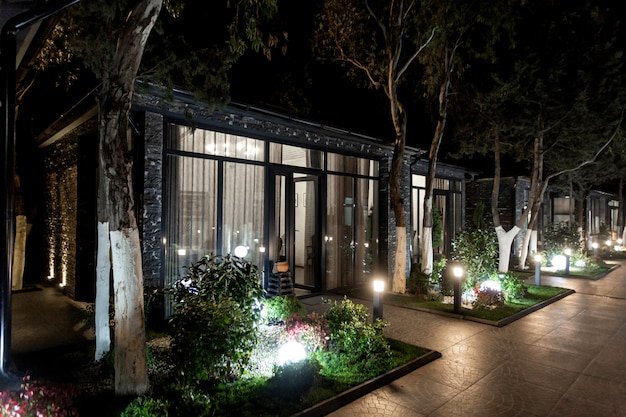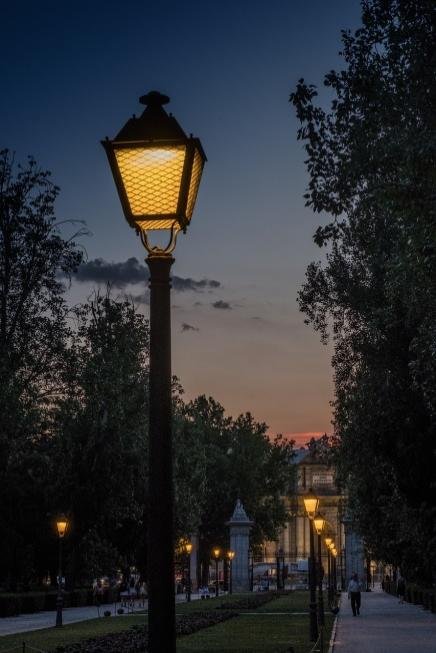Gardens are visual additions to our houses, providing areas for amusement, leisure, and aesthetic appreciation. To fully appreciate these outdoor areas after dark, garden lighting is essential. It transforms spaces, enhances safety, and creates captivating ambiances. At the core lies the photocell, a small yet crucial component that intelligently controls when lights turn on and off based on ambient light levels.

(Copyright-free source: https://www.freepik.com/free-photo/outside-view-restaurant-cottage-night-time_7735515.htm#fromView=search&page=1&position=5&uuid=44f9f3f1-e15f-4827-8fd1-24045ebb4871)
The Importance of Garden Lighting
Outdoor lighting is not just for brightening garden areas; it is a form of art that has the power to turn your garden from a plain green space into a mystical hideaway. Strategically positioning lights can emphasize architectural elements, showcase beautiful plants, design welcoming walkways, and improve safety measures. Furthermore, garden lighting increases the practicality of your outdoor area, enabling you to appreciate its aesthetics well into the evening.
The Role of Photocells in Garden Lighting
Photocell sensor are crucial in contemporary garden lighting. These compact, photo-sensitive gadgets serve as the central control for your outdoor lighting setup. Photocells automatically switch lights on and off by sensing changes in light levels in the surroundings. This saves energy and guarantees steady lighting without requiring manual changes.
Understanding the Basic Functions of Photocells
Choosing the right photocell for your garden requires an understanding of how they work fundamentally. The component of a photocell that responds to light generates a little electric current when it comes into contact with light. When light falls below a certain threshold, the photocell sensor outdoor lights detects it and triggers the lighting system. On the other hand, when daylight increases, the photocell switches off the electricity, dimming the lights.
While the majority of photocells act on an on/off basis, more sophisticated ones come with extra capabilities including time delay functions, customizable sensitivity, and compatibility with different lighting systems. Knowing these basic ideas can help you choose a photocell for your yard lighting project with knowledge.
How to Match the Right Photocell with Garden Lights
A. Based on the Appearance of Garden Lights
The choice of photocell significantly impacts the aesthetic and functionality of your garden lighting. Let’s explore the best options for different types of lights:
Bulbs
- Wire-in photocells: These are the most common type and offer flexibility. They’re usually installed on walls or other structures, providing a clean look.
- Bulb-mounted photocells: For a discreet solution, these photocells fit directly into light bulb sockets, making them ideal for smaller fixtures.
Lamp-post Photocells
- Wire-in photocells: Designed specifically for lamp posts, these photocells seamlessly integrate with the fixture’s design. They offer a polished and professional appearance.
Festive Decorative Lights
- DC wire-in photocells: These are suitable for low-voltage decorative lights, ensuring safe operation. They often come with weatherproof enclosures for outdoor use.
Outdoor Street Lights
- Twist-lock photocells: Designed to be durable and reliable, these photocells are built to endure extreme weather conditions. They usually have a reliable locking system for extra security.
The type of light fixture and how it will be utilized are significant considerations when selecting the proper photocell for your garden lighting. This will enhance the appearance and functionality of your outdoor lighting.

(Copyright-free source: https://pixabay.com/photos/sunset-street-lamp-light-warmth-2441776/)
B. Base on the Nature of the Lighting Fixtures
The type of light source also influences photocell selection.
Electronic Photocells: LED Lights
The characteristics of electronic photocontrols and LED lighting fixtures make them an ideal combination. Here are the specific reasons why LED lighting fixtures are more suitable for electronic photocontrols rather than thermal photocontrols:
High Precision and Quick Response
Electronic Photocontrols: Provide high-precision light sensing and fast response times.
LED Lighting Fixtures: Have instant on/off capabilities, perfectly matching the quick response of electronic photocontrols.
Energy Efficiency and Conservation
Electronic Photocontrols: Precisely detect light, avoiding unnecessary power consumption and thus enhancing energy efficiency.
LED Lighting Fixtures: Are inherently energy-efficient light sources. When paired with electronic photocontrols, they further optimize the overall system’s energy-saving performance, minimizing power consumption to the greatest extent.
Thermal photocells: Fluorescent Lights, Halogen Lights, High-Pressure Sodium Lamps, etc.
Thermal photocontrols have unique advantages when controlling fluorescent lamps and high-pressure sodium lamps etc. Here are the detailed reasons:
1. Durability and Stability
- High Temperature Resistance:
High-pressure sodium lamps and fluorescent lamps generate a lot of heat during operation. Thermal photocontrols can withstand high-temperature environments and are not easily damaged by temperature changes, making them suitable for long-term stable operation.
2. Economical
- Lower Cost:
Thermal photocontrols are less expensive compared to electronic photocontrols, making them suitable for applications with limited budgets that still require basic automatic control functions.
3. Adaptability
- Suitable for Environments with Varying Light Conditions:
Thermal photocontrols are highly adaptable to changes in ambient light and are not easily affected by sudden changes in light conditions, making them ideal for outdoor areas with varying light conditions.
4. Simple Structure
- Easy to Install and Replace:
The simple structure of thermal photocontrols makes them easy to install and replace, suitable for large-scale applications and routine maintenance.
5. Load Adaptability
- Handles High-Power Loads:
Thermal photocontrols can handle larger current loads, making them very suitable for high-power high-pressure sodium lamps and fluorescent lamps.
In summary, thermal photocontrols are highly suitable for controlling fluorescent lamps and high-pressure sodium lamps due to their durability, economical cost, adaptability, simple structure, and load adaptability. They provide a reliable, low-cost light control solution that meets the needs of long-term stable operation.
- High-Power Fixtures
- High-end high-power photocells: For high-intensity lighting applications, specialized photocells like those offered by Zhejiang Lingtuo Electric Co., Ltd. are necessary. Models such as LT134 (20KV, 10KA) and LT105E (105-528VAC) are designed to handle the demanding electrical loads of these fixtures.
(Source: https://leaditop.com/product/outdoor-automatic-daylight-sensor-switch-for-led-light/)
Ensuring the optimal performance and endurance of your outdoor lighting system can be achieved by considering the distinctive features of your lighting fixtures.
C. Choose Photocells Based on Functional Needs
Automatic Light Switching Based on Light Intensity
The primary function of a photocell is to automatically regulate lighting based on the level of ambient light. This eliminates the necessity of manual modifications and ensures optimal energy efficiency. Most photocells offer a simple on/off feature, activating lights in darkness and turning them off in light.
In contrast, certain photocells provide advanced features such as the ability to adjust sensitivity. By doing this, you have the ability to modify the precise level of brightness at which the lights switch on or off. For instance, you can adjust the photocell settings to switch on lights when the light level is higher to ensure sufficient lighting in cloudy conditions.
Need for Smart Photocells
Smart photocells are becoming more popular in today’s interconnected society. These gadgets offer enhanced capabilities and smooth integration with other smart home setups. Smart photo sensors can be controlled from a distance, allowing you to adjust lighting preferences. Furthermore, they can be customized to follow personalized lighting schedules such as slowly lowering the brightness of lights at night or simulating occupancy in a home.
Some smart photocells offer features like daylight harvesting, utilizing additional sunlight to reduce the need for artificial lighting. By incorporating smart photocells into your outdoor lighting system, you can achieve enhanced control, effectiveness, and convenience.
Conclusion
Choosing the correct photocell is vital for establishing a successful and productive garden lighting system. When making your decision, consider the type of light fixture, light source, desired functions, and specific requirements. By matching photocells to your garden lights and considering factors like light intensity and smart features, you can optimize energy consumption, enhance safety, and create a captivating outdoor ambiance. Remember, the perfect photocell is the one that meets your unique needs.
For more detailed information or assistance in selecting the ideal photocell for your garden, feel free to contact us anytime. Zhejiang Leadtop Electrical Co., Ltd. is here to help.
Visit our website: www.leaditop.com
Email us at: info@leaditop.com
Further Resources:
- https://learn.adafruit.com/photocells/overview
- https://oer.unizik.edu.ng/wp-content/uploads/sites/6/2017/10/Photocells.pdf
- https://www.pcmag.com/encyclopedia/term/photocell
- https://www.elprocus.com/photocell-working-and-its-applications/
- https://en.wikipedia.org/wiki/Landscape_lighting
- https://resortlightinginc.com/history-of-lighting/brief-history-of-ourdoor-lighting-20th-century-to-today/








